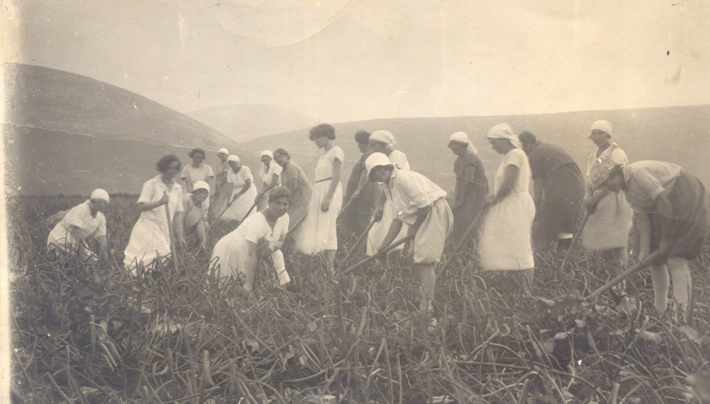
In the late 19th century, a small number of Jews from Eastern Europe – some families, socialist single men, and a very few young women – settled in what was then Palestine, with the hope of fulfilling Theodor Herzl’s vision of a homeland for the Jewish people. Believing that Diaspora Jews were weak and unproductive, these pioneers sought to change the Jewish character to form a “New Jew,” the sabra, who would be strong, able to defend him or herself, and productive. Indeed, in the eyes of Herzl and his contemporaries, productivity meant one thing: engaging in agriculture.
The few women who traveled to Palestine were expected to work in the kitchen, wash the men’s clothes, and, perhaps, engage in some limited, home-based farming. To be historically fair, voting rights had not yet been granted to women in either the USA (1920) or the UK (1928). Nonetheless, some of these women were determined to partake fully in the Zionist endeavor, aspiring to be equal partners with men in making the barren land bloom.
In 1911, Hannah Meisel, a Russian immigrant with a Ph.D. in agronomy, established a women’s farm, an agricultural training institution for young women. Leasing a room from a Jewish settlement next to the Sea of Galilee, she came with two students; four others joined her later. The girls, 16 or 17 years old, were eager to master every theoretical and practical aspect of agronomy.
At first, the girls and their teacher lived in one room, with neither floor nor windows, but eventually the school had its own house, and other girls quickly followed the first students. News of this revolutionary school for women in Palestine spread so quickly within Zionist circles that Meisel had to reject some applicants because she could accommodate only 20 girls at a time.
Following eight hours in the fields, the girls’ evenings were devoted to general education. They specialized in growing unique fruits and vegetables and established a nursery that provided hundreds of olive, lemon, almond, and eucalyptus seedlings for other farms. They experimented with planting bananas, a common crop in certain parts of Israel today. Their eucalyptus trees helped dry the swamps that harbored mosquitoes carrying malaria and other diseases. They operated a productive dairy barn, and tended a decorative flower garden that was another of their innovations.
Despite her revolutionary spirit, Meisel was extremely practical and believed that after two years of schooling, the girls would marry and settle down with a husband and children. Therefore, she insisted that they also learn “household management,” including cooking, sewing, cleaning. Her aim was to create a farmer’s wife with some agricultural skills. But the girls, now an integrated group of determined young women who had endured hardships and maladies, developed an altogether different image of their role in society. They wanted to engage in agriculture as their main vocation, not just for the sake of supporting husbands or families.
The protests against “household management” evolved into an open rift with Meisel, whom the girls referred to as “our older sister.”
“What sort of subject is that?” they wondered.
Some cleaned the kitchen out of respect for her, others openly refused, and still others pretended to clean, but left the oven and pots dirty. The feminist ideas that developed within the group could not be shaken, even by the fierce stand of their respected teacher.
It is most likely that if Meisel had only one or two students, they would have adopted her worldview. But the united group she created wanted a new lifestyle and formed new perceptions of gender roles that were more radical than her own. Their mutual support made the different, innovative feminine identity possible. In many ways they were ahead of their time, a true “avant-garde.”
The women’s farm lasted for six and a half years, until the outbreak of World War I created new, insurmountable obstacles to its continuation. Yet the determination and collective spirit of these young women not only had a profound and long-lasting effect on Israeli society, but also helped create and sustain the image of the Israeli sabra.
Emanuela Rubinstein is the author of two books dealing with cultural interpretations of the Holocaust: The Devil, the Church, and the Saints: Reading Hochhuth’s The Deputy (Peter Lang, 2004) and The Nazi Devil (The Hebrew University Magnes Press, 2010). Her upcoming book, Mephisto in the Third Reich, is expected in 2014. Rubinstein is part of the Nevzlin Center for Jewish Peoplehood and Interdisciplinary Center (IDC) in Herzliya, Israel. Her bilingual blog, On Ourselves and Others, is written in English and Hebrew, and highlights cultural issues with an Israeli perspective.

